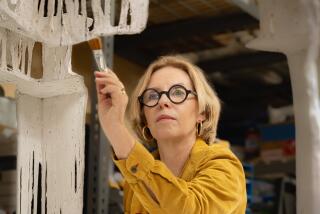The Registrar Has a Revelation : FIRST LIGHT A Magical Journey <i> by Carol O’Biso (Paragon House: $16.95;</i> 2<i> 24 pp.; 1-55778-207-5) </i>
- Share via
Historically, the collecting of tribal art or artifacts and cult objects manifests the Western attitude toward other cultures. As objects of curiosity, they have often been viewed as “trophies” and more recently, as ethnographic samples.
Explorers, “conquerors,” and millionaires have filled the museums of Europe and America with collections of artifacts--booty or bounty or souvenirs of their travels and exploitations. The way in which these objects were/are viewed differs radically from the reverence or veneration with which they were created and held within their own culture. Collections in the British Museum, for instance, may lie in storage for years and when displayed, lack any connotative reference to their temporal or spatial realities.
In “The Predicament of Culture,” (Harvard University Press, 1988) James Clifford debated this Western penchant for curious or fascinating “things,” which when removed from a spatial and temporal environment lose their spiritual meaning or power. In the broken segments of what we define as culture, the perception with which the object is viewed or sensed gives it existence, or strips it of meaning.
The denial and discovery of that power, what Walter Benjamin defines as essence or “aura,” and which Carlos Castanada calls “intent,” is the underlying premise of Carol O’Biso’s “First Light: A Magical Journey.” A registrar for the American Federation of Arts, O’Biso is sent to New Zealand to make the arrangements for a touring exhibition of Maori tribal art. Through journal entries, letters and a dramatic first-person narrative, she describes her own personal shifts of perception through her contract with the New Zealanders, particularly the Maori, the country itself, and the objects entrusted to her care as well as the enormous task of preparing, crating and shipping the exhibition to the United States.
Vaguely amused initially by all the ritual transfer ceremonies, which are mandatory in every museum site from which work is to be loaned, O’Biso’s amusement turns into frustration when a large group of Maori elders confronts her to protest their “ancestors” removal from their land:
“The Mafia Don carried a carved walking stick seven hundred years old that has been handed down through his family. He said it is his ancestor so-and-so whose name, of course, I can neither pronounce nor remember. . . . I dare anyone sitting on Madison Avenue . . . to recommend what I should have said to a middle-aged man in a business suit feeding tea and cookies to his walking stick!”
How can an inanimate object be someone’s ancestor, she wonders, reflecting the reader’s own skeptical view? But a change occurs when an elder tribal member personally entrusts the objects to her in his name and she begins to understand that the power failure that occurs just as she is about to photograph a piece and when false fire alarms and blackouts delay the final packing may not be coincidence. By the time “Te Maori” opens in New York, her commitment to it and her belief in the objects is so total that she makes extraordinary professional efforts to personally oversee every detail of its travel and installation through its itinerary.
Reminiscent of Castaneda’s work in its description of a personal shift from skeptical observer to believer-participant, O’Biso’s “First Light” nonetheless lacks the dramatic force that makes Castaneda’s accounts so immediate. We are never really sure how this change came about. Where is the magical moment, the encounter with what Mircea Eliade or Joseph Campbell would refer to as that “psychic rupture” or “seizure,” which determines the change of life or “calling”? While we share her wonder and her irritation, the narrative misses on that account. “With those few strokes of the pen, a chapter in my life somehow ended and another began” she states halfway through the book. The merit of her storytelling lies in her ability to describe a contemporary society in harmony with its past and own her personal reverence and respect for a way of life unknown to her before the New Zealand adventure.
More to Read
The biggest entertainment stories
Get our big stories about Hollywood, film, television, music, arts, culture and more right in your inbox as soon as they publish.
You may occasionally receive promotional content from the Los Angeles Times.










